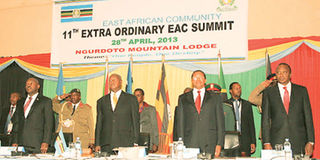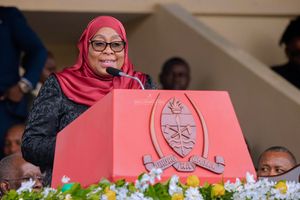The 56 million who live, die poor in EAC

As East African leaders struggle with issues of isolation, integration, political federation, and numerous protocols, the majority of their people are languishing in abject poverty with 40 to 80 per cent of children from poverty stricken households dying before their fifth birthday
What you need to know:
The 56-million strong poor have an average income of a paltry $226 (Sh372,900) per annum – an trifle amount that can not even sustain an average-size family for a month.
Dar es Salaam/Arusha. As East African leaders struggle with issues of isolation, integration, political federation, and numerous protocols, the majority of their people are languishing in abject poverty with 40 to 80 per cent of children from poverty stricken households dying before their fifth birthday.
This category has a combined population of 56 million people with an average income of a mere $226 (Sh372,900) a year – clearly not even sufficient enough to feed a family for one calendar month.
The poor, according to the ‘State of the East African Community’ report released last weekend, control about $12.7 billion of the East African region’s combined gross domestic product (GDP), which is a tiny 15 per cent of the total $83 billion for the five countries.
The poverty-stricken East Africans mostly live in rural areas or in the slums of major towns and cities. The lucky find work but only receive a wage that is below the poverty line.
They have no health insurance and their children face a 40 to 80 per cent higher chance of dying before their fifth birthday compared to their richer compatriots.
Those who survive are likely to be stunted. They attend schools lacking basic utilities such as power, water and sanitation and they are taught for only a quarter of the recommended time.
This combination of poor nutrition and negligible schooling leaves them unable to operate in East Africa’s modernising, service-oriented economy and guarantee that they will bequeath their poverty to their children and grandchildren.
The ‘East Africa’ they live in cannot even be compared to the war-torn states of Somalia or the Democratic Republic of Congo (DRC).
This is the grim picture painted by the State of East African report titled, ‘One People, One Destiny: the future of inequality in East Africa’ compiled by Society for International Development (SID).
The reports says about 71 million or 50 per cent of the EAC region’s population earned $586 (Sh966,900), which in terms of money value could feed this group for hardly four months.
The group termed by the report has middle majority controls of about 50 per cent of the combined region’s GDP.
According to the 120-page report made available to The Citizen, there is a pervasive feeling that the economic conditions have worsened in the past five years in the region despite major discoveries of natural resources, especially natural gas, oil and minerals.
For instance, the report says, in the 2012 Tanzania Afrobarometer Survey, 40 per cent of adults felt that current economic conditions in Tanzania were very bad, compared to 25 per cent in 2008.
In 2012, 62 per cent of Ugandans felt that their living conditions were at least fairly bad compared to 42 per cent just two years earlier.
In Kenya, 84 per cent of adults described the current economic conditions as either ‘very bad’ or ‘fairly bad’ in 2011; a 30-point jump from 54 per cent in 2005 region could soon be a strong feature of its economic relationship with donor countries.
Burundi, according to the report is the least unequal country in East Africa, followed, in order of rising inequality, by Tanzania, Uganda, Kenya and Rwanda.
The trends in the last two decades point to Rwanda and Burundi as reducing inequality more, albeit from a very high level in Rwanda.
Kenya and Tanzania seem to be expanding the gap between the rich and the poor, while Uganda has kept its status mostly stable for two decades, the report says.
The report points out further that a formal, wage-paying job is a privilege reserved for a tiny minority of East Africa’s working population.
Just 1.6 per cent of Uganda’s, 4 per cent of Burundi’s, 5 per cent of Tanzania’s and 6 per cent of Kenya’s working populations are formally employed.
For those fortunate enough to find a paying job, the wage data highlights further the disparity in earnings.
The lowest official monthly minimum wages across East Africa varies from $81 in Uganda to just $3.10 in Burundi -- which is four times lower than its official poverty line of $12.
The median monthly wage ranges from $176 in Rwanda to $84 in Tanzania.
However, at $176, Rwanda’s median wage is lower than its own official poverty line ($192) and furthermore, less than half of working Rwandans were paid a wage that was higher than the country’s poverty line.
An analysis of income distribution data, wage differentials, access to health and education services, nutrition indicators and even the prevalence of birth registration allows a grouping of East Africans into three major populations of unequal size and wellbeing.
The probability of upward social mobility is determined by the nutritional quality, health and learning that are obtained during the first 1,000 days of life for most people.
The good news includes the fact that infant and under-five mortality rates have decreased significantly across East Africa’s wealth spectrum, demonstrating progress made in improving early childhood healthcare, particularly vaccination, across the board.
Analysis of the data on stunting among children, a sign of malnutrition, makes for sobering reading.
The share of stunted children in Tanzania and Kenya expanded in both rich and poor households.
The gap between rich and poor children in both countries narrowed but for the wrong reason; stunting among children in the richer households grew at a faster pace than that of their poorer compatriots.
This gap also widened in Rwanda, but it was because the rate of stunting fell faster among richer children than poorer ones.
In Uganda, the gap closed as stunting fell overall but it did so faster among the country’s poorest children.
The difference in the quality of social service delivery highlights the urban-rural inequality.
In Tanzania, 60 per cent of urban health facilities have electricity, clean water and improved sanitation compared to just five per cent of rural facilities.
In Kenya 58 per cent of health facilities in urban areas share the same advantage of infrastructure.
The East African economy continued its impressive growth rate trend with an average of 6 per cent growth in 2011 and a GDP of $83 billion in that year.
However, income per capita data for 2011 shows the significant intra-regional differences between Burundi’s per capita income of $271 and Kenya’s $808.
But, in terms of money value, the 6 per cent impressive growth was still not impacting lives of the estimated 140 million people in the region.
East Africa attracted foreign direct investment (FDI) inflows of $3.9 billion in 2012, a $1.8 billion increase from $2.6 billion in 2011.
With a combined total inflow of $3.4 billion, the two main energy- rich countries of Uganda and Tanzania received 90 per cent of the inflows.
In addition to the lure of the extractives sector, other investors in East Africa are targeting regional and domestic consumers with healthcare, financial services and cement production.
The share of industry in the economy increased modestly in four of the five East African countries. East Africa’s industrial sector employed about 560,000 workers in 2012.
Assuming a labour force of about 77 million in 2010, industrial employment accounted for less than 1 per cent of the region’s total labour force.
In order to reach the goal of having 2.3 million people working in manufacturing, the region’s industrial sector jobs will have to expand five times in the next 20 years.
It would be unfair to blame regional integration for this state of inequality in East Africa.
It can be argued, however, on the basis of the evidence presented, that the strong economic growth performance that has been unleashed by regional integration efforts, has done little to close the gap between the rich and poor.
Two powerful driving forces are shaping the future of inclusiveness and equity in East Africa.
One is the inclusiveness of growth - a measure of how much the poorest East Africans are participating in generating economic growth.
The second driving force is the degree of equity, which describes how the benefits of economic growth are shared among the region’s citizens, and particularly the share of income and wealth that accrues to the poorest East Africans.
The report further says, ‘the winner takes all’ outlook describes a future in which the poorest are excluded from participating in East Africa’s growth process.




